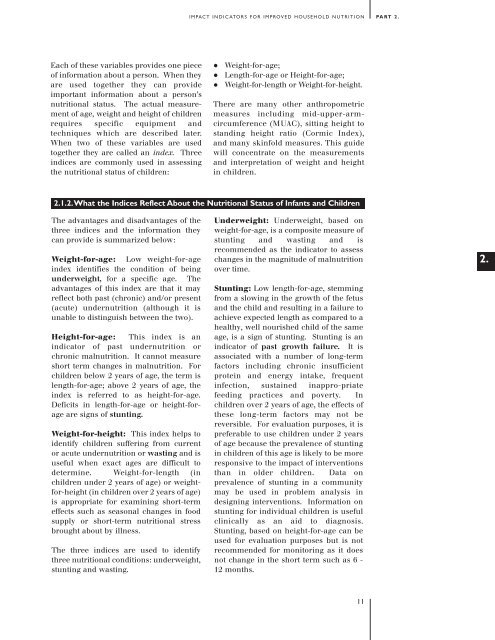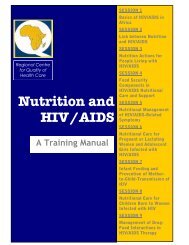2.1: Anthropometric Indicators Measurement Guide - Linkages Project
2.1: Anthropometric Indicators Measurement Guide - Linkages Project
2.1: Anthropometric Indicators Measurement Guide - Linkages Project
You also want an ePaper? Increase the reach of your titles
YUMPU automatically turns print PDFs into web optimized ePapers that Google loves.
IMPACT INDICATORS FOR IMPROVED HOUSEHOLD NUTRITION PART 2.<br />
Each of these variables provides one piece<br />
of information about a person. When they<br />
are used together they can provide<br />
important information about a person’s<br />
nutritional status. The actual measurement<br />
of age, weight and height of children<br />
requires specific equipment and<br />
techniques which are described later.<br />
When two of these variables are used<br />
together they are called an index. Three<br />
indices are commonly used in assessing<br />
the nutritional status of children:<br />
Weight-for-age;<br />
Length-for-age or Height-for-age;<br />
• Weight-for-length or Weight-for-height.<br />
There are many other anthropometric<br />
measures including mid-upper-armcircumference<br />
(MUAC), sitting height to<br />
standing height ratio (Cormic Index),<br />
and many skinfold measures. This guide<br />
will concentrate on the measurements<br />
and interpretation of weight and height<br />
in children.<br />
<strong>2.1</strong>.2.What the Indices Reflect About the Nutritional Status of Infants and Children<br />
The advantages and disadvantages of the<br />
three indices and the information they<br />
can provide is summarized below:<br />
Weight-for-age: Low weight-for-age<br />
index identifies the condition of being<br />
underweight, for a specific age. The<br />
advantages of this index are that it may<br />
reflect both past (chronic) and/or present<br />
(acute) undernutrition (although it is<br />
unable to distinguish between the two).<br />
Height-for-age: This index is an<br />
indicator of past undernutrition or<br />
chronic malnutrition. It cannot measure<br />
short term changes in malnutrition. For<br />
children below 2 years of age, the term is<br />
length-for-age; above 2 years of age, the<br />
index is referred to as height-for-age.<br />
Deficits in length-for-age or height-forage<br />
are signs of stunting.<br />
Weight-for-height: This index helps to<br />
identify children suffering from current<br />
or acute undernutrition or wasting and is<br />
useful when exact ages are difficult to<br />
determine. Weight-for-length (in<br />
children under 2 years of age) or weightfor-height<br />
(in children over 2 years of age)<br />
is appropriate for examining short-term<br />
effects such as seasonal changes in food<br />
supply or short-term nutritional stress<br />
brought about by illness.<br />
The three indices are used to identify<br />
three nutritional conditions: underweight,<br />
stunting and wasting.<br />
Underweight: Underweight, based on<br />
weight-for-age, is a composite measure of<br />
stunting and wasting and is<br />
recommended as the indicator to assess<br />
changes in the magnitude of malnutrition<br />
over time.<br />
Stunting: Low length-for-age, stemming<br />
from a slowing in the growth of the fetus<br />
and the child and resulting in a failure to<br />
achieve expected length as compared to a<br />
healthy, well nourished child of the same<br />
age, is a sign of stunting. Stunting is an<br />
indicator of past growth failure. It is<br />
associated with a number of long-term<br />
factors including chronic insufficient<br />
protein and energy intake, frequent<br />
infection, sustained inappro-priate<br />
feeding practices and poverty. In<br />
children over 2 years of age, the effects of<br />
these long-term factors may not be<br />
reversible. For evaluation purposes, it is<br />
preferable to use children under 2 years<br />
of age because the prevalence of stunting<br />
in children of this age is likely to be more<br />
responsive to the impact of interventions<br />
than in older children. Data on<br />
prevalence of stunting in a community<br />
may be used in problem analysis in<br />
designing interventions. Information on<br />
stunting for individual children is useful<br />
clinically as an aid to diagnosis.<br />
Stunting, based on height-for-age can be<br />
used for evaluation purposes but is not<br />
recommended for monitoring as it does<br />
not change in the short term such as 6 -<br />
12 months.<br />
2.<br />
11

















